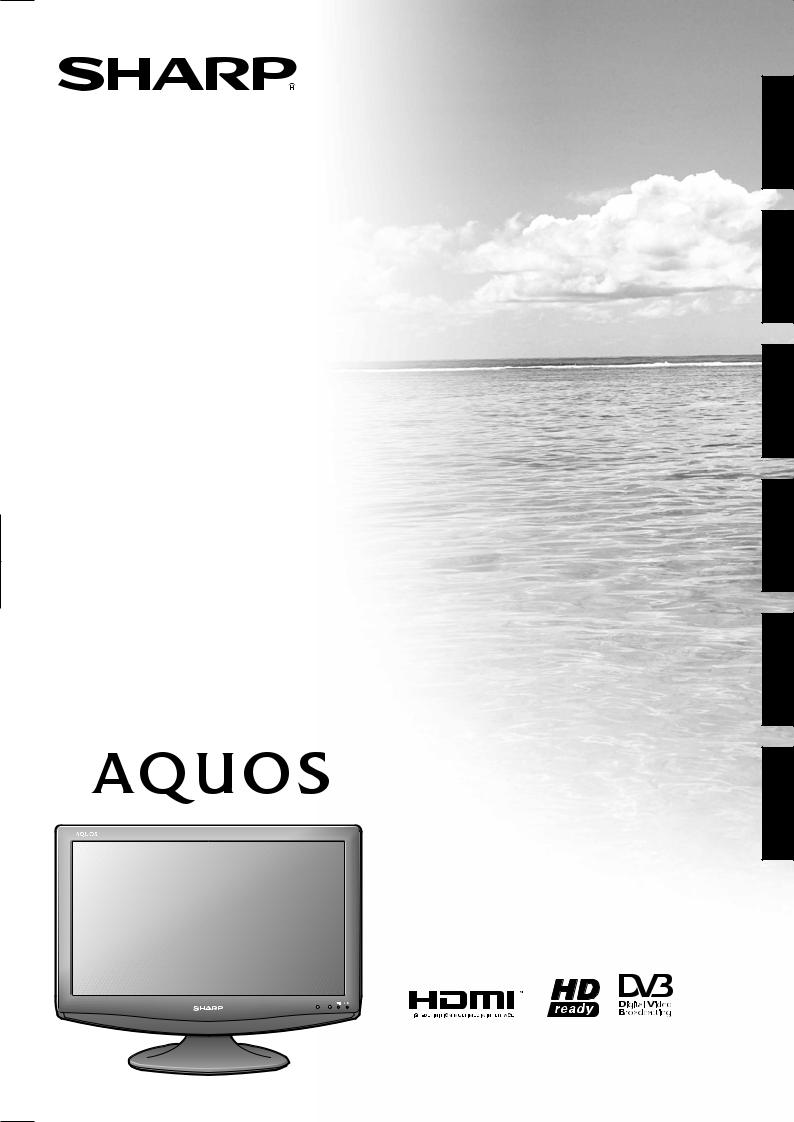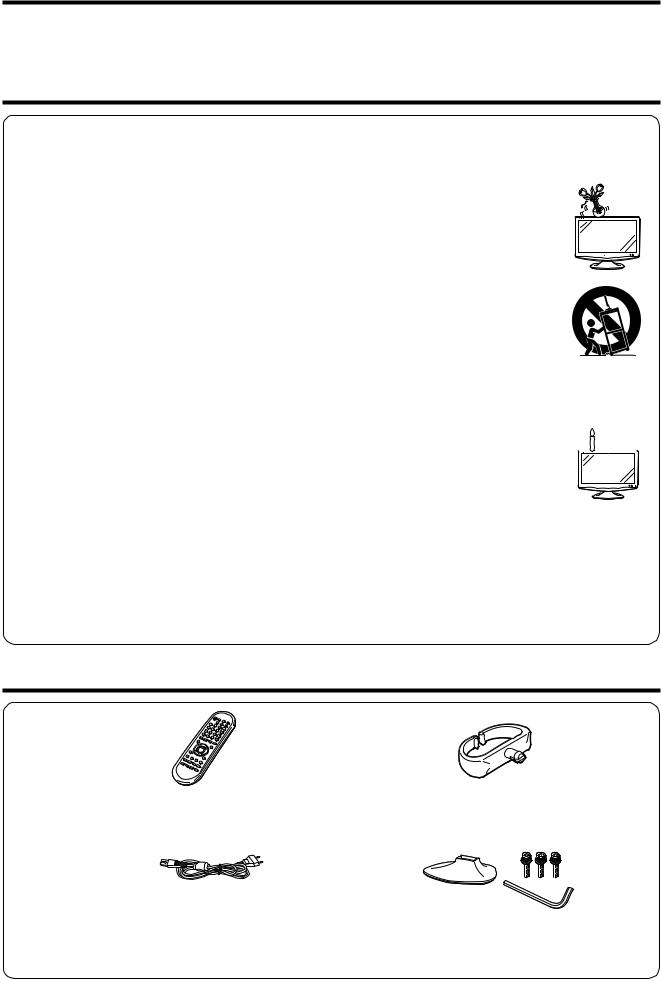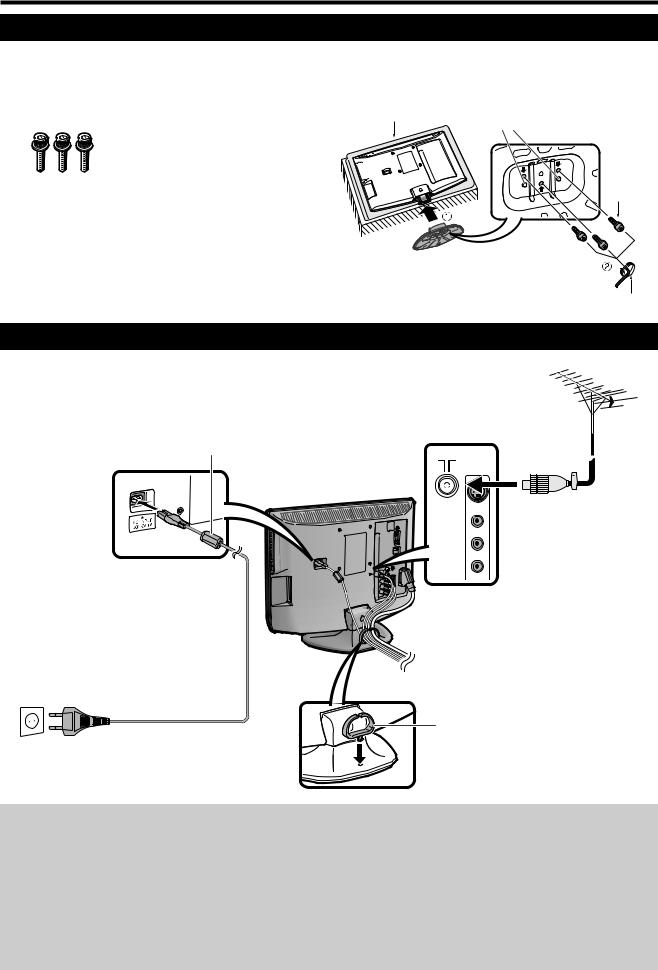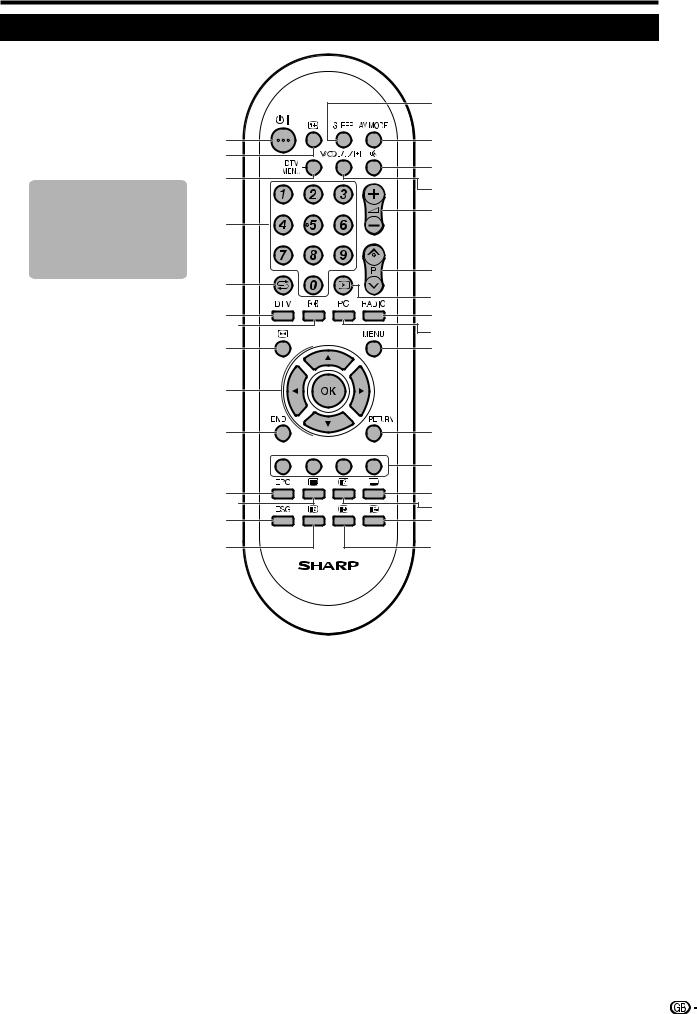Sharp LC-19D1E, LC-19D1S Operating Manual

LC-19D1E
LC-19D1S
LCD COLOUR TELEVISION
LCD-FARBFERNSEHGERÄT
TÉLÉVISEUR COULEUR À ÉCRAN
CRISTAUX LIQUIDES (LCD)
TELEVISORE A COLORI LCD
LCD-KLEURENTELEVISIE
TELEVISIÓN EN COLOR LCD
OPERATION MANUAL
BEDIENUNGSANLEITUNG
MODE D’EMPLOI
MANUALE DI ISTRUZIONI
GEBRUIKSAANWIJZING
MANUAL DE MANEJO
ENGLISH
DEUTSCH
FRANÇAIS
 ESPAÑOL NEDERLANDS ITALIANO
ESPAÑOL NEDERLANDS ITALIANO

SPECIAL NOTE FOR USERS IN THE U.K.
The mains lead of this product is fitted with a non-rewireable (moulded) plug incorporating a 13A fuse. Should the fuse need to be replaced, a BSI or ASTA approved BS 1362 fuse marked  or ASA and of the same rating as above, which is also indicated on the pin face of the plug, must be used.
or ASA and of the same rating as above, which is also indicated on the pin face of the plug, must be used.
Always refit the fuse cover after replacing the fuse. Never use the plug without the fuse cover fitted.
In the unlikely event of the socket outlet in your home not being compatible with the plug supplied, cut off the mains plug and fit an appropriate type.
DANGER:
The fuse from the cut-off plug should be removed and the cut-off plug destroyed immediately and disposed of in a safe manner.
Under no circumstances should the cut-off plug be inserted elsewhere into a 13A socket outlet, as a serious electric shock may occur.
To fit an appropriate plug to the mains lead, follow the instructions below:
IMPORTANT:
The wires in the mains lead are coloured in accordance with the following code:
Blue: Neutral
Brown: Live
As the colours of the wires in the mains lead of this product may not correspond with the coloured markings identifying the terminals in your plug, proceed as follows:
•The wire which is coloured blue must be connected to the plug terminal which is marked N or coloured black.
•The wire which is coloured brown must be connected to the plug terminal which is marked L or coloured red. Ensure that neither the brown nor the blue wire is connected to the earth terminal in your three-pin plug. Before replacing the plug cover make sure that:
•If the new fitted plug contains a fuse, its value is the same as that removed from the cut-off plug.
•The cord grip is clamped over the sheath of the mains lead, and not simply over the lead wires.
IF YOU HAVE ANY DOUBT, CONSULT A QUALIFIED ELECTRICIAN.

OPERATION MANUAL |
ENGLISH |
|
|
•The illustrations and the OSD (On-Screen Display) in this operation manual are for explanation purposes and may vary slightly from the actual operations.
•The marks (-BK, -WH and etc.) at the end of model name represent the colour of the TV cabinet.
TV/AV only |
TV only |
: these icons used throughout this manual indicate the menu item can be set or adjusted |
||
TV/DTV/AV only |
PC only |
only in the selected input mode. |
||
• “PC only” refers to the PC input EXT 5 terminal and does not include PC input (HDMI- |
||||
|
|
PC input) on the EXT 4 (HDMI) terminal. |
||
|
|
• HDMI-PC: PC (RGB) input on the EXT 4 (HDMI) terminal |
||
Contents |
• The HDMI-PC input is compatible with VGA. |
|||
|
|
|
||
|
|
|
||
Trademarks ………………………………………………………… |
1 |
WSS (Wide Screen Signalling) ………………………… 15 |
||
Dear SHARP customer …………………………………………… |
2 |
4:3 Mode ………………………………………………… 15 |
||
Important Safety Precautions |
………………………………… |
2 |
Rotate …………………………………………………… 16 |
|
Supplied accessories …………………………………………… |
2 |
Language ………………………………………………… 16 |
||
Quick guide ………………………………………………………… |
3 |
Supply Voltage ………………………………………… 16 |
||
Attaching the stand …………………………………………… |
3 |
Option menu ………………………………………………… 16 |
||
Setting the TV ………………………………………………… |
3 |
DNR (Digital Noise Reduction) ………………………… 16 |
||
Inserting the batteries ………………………………………… |
4 |
Input Select ……………………………………………… 16 |
||
Using the remote control unit ……………………………… |
4 |
Audio Only ……………………………………………… 16 |
||
Cautions regarding the remote control unit ………… |
4 |
Colour System …………………………………………… 16 |
||
Remote control unit …………………………………………… |
5 |
Useful features …………………………………………………… 17 |
||
TV (Front/Side view) ………………………………………… |
6 |
WIDE MODE ………………………………………………… 17 |
||
TV (Rear view) ………………………………………………… |
6 |
Using the analogue programme list ………………………… 17 |
||
Turning on the power ………………………………………… |
7 |
Freezing the image while watching ………………………… 17 |
||
Standby mode ………………………………………………… |
7 |
Teletext function ……………………………………………… 18 |
||
Turning off the power ………………………………………… |
7 |
DTV menu operations …………………………………………… 18 |
||
Initial auto installation (Analogue) ………………………… |
7 |
DTV common operations …………………………………… 18 |
||
Initial auto installation (DTV) ………………………………… |
7 |
About using the character set screen ………………… 19 |
||
Using external equipment ……………………………………… |
8 |
Language ……………………………………………………… 19 |
||
Connecting a VCR …………………………………………… |
8 |
Programme Setup …………………………………………… 19 |
||
Connecting a game console or camcorder ……………… |
8 |
Installation …………………………………………………… 20 |
||
Connecting a DVD player …………………………………… |
8 |
Auto Installation ………………………………………… 20 |
||
Connecting a decoder ……………………………………… |
8 |
Carrier Scan ……………………………………………… 20 |
||
Connecting a PC ……………………………………………… |
9 |
Carrier Setup …………………………………………… 21 |
||
Menu operations |
………………………………………………… |
9 |
System Setup ………………………………………………… 21 |
|
Common operations ………………………………………… |
9 |
OSD Setup ……………………………………………… 21 |
||
AV Mode ……………………………………………………… 10 |
Child Lock ……………………………………………… 21 |
|||
Picture menu |
………………………………………………… 10 |
Accessories …………………………………………………… 22 |
||
OPC ……………………………………………………… 10 |
Version (Software version) ……………………………… 22 |
|||
Picture adjustments |
…………………………………… 10 |
Software Upgrade ……………………………………… 22 |
||
Advanced ………………………………………………… 10 |
Common Interface …………………………………………… 22 |
|||
Audio menu …………………………………………………… 11 |
Inserting a CA card …………………………………… 22 |
|||
Audio adjustments ……………………………………… 11 |
Useful features (DTV) …………………………………………… 23 |
|||
Sound Wide ……………………………………………… 11 |
About EPG …………………………………………………… 23 |
|||
Power Control menu ………………………………………… 12 |
Using the EPG …………………………………………… 23 |
|||
No Signal Off …………………………………………… 12 |
Using the EPG Timer …………………………………… 23 |
|||
No Operation Off ………………………………………… 12 |
Using the ESG ………………………………………………… 23 |
|||
Power Management |
…………………………………… 12 |
Using the digital programme list …………………………… 24 |
||
Setup menu …………………………………………………… 12 |
Displaying subtitles …………………………………………… 24 |
|||
Auto Installation ………………………………………… 12 |
Viewing a service banner …………………………………… 24 |
|||
Programme Setup ……………………………………… 12 |
Using the multi audio function ……………………………… 24 |
|||
Auto Search ………………………………………… 13 |
Using the MHEG5 application (UK only) …………………… 24 |
|||
Manual Adjust ……………………………………… 13 |
Appendix …………………………………………………………… 25 |
|||
Sort ………………………………………………… 14 |
Troubleshooting ……………………………………………… 25 |
|||
Erase Programme ………………………………… 14 |
RS-232C port specifications ………………………………… 26 |
|||
Child Lock ………………………………………………… 14 |
Specifications ………………………………………………… 27 |
|||
Input Label ……………………………………………… 14 |
PC compatibility chart (EXT 5 only) ………………………… 27 |
|||
Position …………………………………………………… 14 |
End of life disposal ……………………………………………… 28 |
|||
PC Setup ………………………………………………… 15 |
|
|||
HDMI Audio Select ……………………………………… 15 |
|
|||
HDMI Auto View ………………………………………… 15 |
|
|||
Trademarks
ENGLISH
•“HDMI, the HDMI logo and High-Definition Multimedia Interface are trademarks or registered trademarks of HDMI Licensing LLC.”
•The “HD ready” Logo is a trademark of EICTA.
•The DVB logo is the registered trademark of the Digital Video Broadcasting - DVB - project.

 1
1

Dear SHARP customer
Thank you for your purchase of the SHARP LCD colour TV product. To ensure safety and many years of troublefree operation of your product, please read the Important Safety Precautions carefully before using this product.
Important Safety Precautions
•Cleaning—Unplug the AC cord from the AC outlet before cleaning the product. Use a damp cloth to clean the product. Do not use liquid cleaners or aerosol cleaners.
•Water and moisture—Do not use the product near water, such as bathtub, washbasin, kitchen sink, laundry tub,
swimming pool and in a wet basement.
• Do not place vases or any other water-filled containers on this product. The water may spill onto the product causing fire or electric shock.
• Stand—Do not place the product on an unstable cart, stand, tripod or table. Doing so can cause the product to fall, resulting in serious personal injuries as well as damage to the product. Use only a cart, stand, tripod, bracket or table recommended by the manufacturer or sold with the product. When mounting the product on a wall, be sure to follow the manufacturer’s instructions. Use only the mounting hardware recommended by the manufacturer.
•When relocating the product placed on a cart, it must be moved with utmost care. Sudden stops, excessive force and uneven floor surface can cause the product to fall from the cart.
•Ventilation—The vents and other openings in the cabinet are designed for ventilation. Do not
cover or block these vents and openings since insufficient ventilation can cause overheating and/or shorten the life of the product. Do not place the product on a bed, sofa, rug or other similar surface, since they can block ventilation openings. This product is not designed for builtin installation; do not place the product in an enclosed place such as a bookcase or rack, unless proper ventilation is provided or the manufacturer’s instructions are followed.
•The LCD panel used in this product is made of glass. Therefore, it can break when the product is dropped or impact applied. If the LCD panel is broken, be careful not to be injured by broken glass.
•Heat sources—Keep the product away from heat sources such as radiators, heaters, stoves and other heatgenerating products (including amplifiers).
• To prevent fire, never place any type of candle or naked flames on the top or near the TV set.
• To prevent fire or shock hazard, do not place the AC cord under the TV set or other heavy items.
•Do not display a still picture for a long time, as this could cause an afterimage to remain.
•There is power consumption always if main plug is connected.
• Servicing—Do not attempt to service the product yourself. Removing covers can expose you to high voltage and other dangerous conditions. Request a qualified person to perform servicing.
The LCD panel is a very high technology product, giving you fine picture details.
Due to the very large number of pixels, occasionally a few non-active pixels may appear on the screen as a fixed point of blue, green or red.
This is within product specifications and does not constitute a fault.
Precautions when transporting the TV
When moving the TV, it should always be carried by two people, using both hands, be careful not to apply pressure to the display.
Supplied accessories
Remote control unit (g1) |
Cable clamp (g1) |
|||||
Pages 4 and 5 |
Page 3 |
|||||
|
|
|
|
|
|
|
|
|
|
|
|
|
|
|
|
|
|
|
|
|
Product shape varies in some countries. |
|
|
AC cord (g1) |
Stand unit (g1) |
|
Page |
3 |
Page 3 |
• “AA” size battery (g2)...........Page 4 |
• Operation manual (This publication) |
|

 2
2

Quick guide
Attaching the stand
Before performing work spread cushioning over the base area to lay the TV on, making sure the area is completely flat. This will prevent it from being damaged.
Before attaching (or detaching) stand, unplug the AC cord from the AC INPUT terminal.
1 Confirm the 3 screws supplied with the TV. |
Soft cushion |
Screws (m3)
(used in step 3)
2 Insert the stand into the opening on the bottom of the TV. (1)
3 Insert and tighten the 3 screws on the bottom of the TV as shown. (2)
NOTE
• To detach the stand, perform the above steps in reverse order.
Alignment protrusions
Screw
Hex key
Setting the TV
Place the TV close to the AC outlet, and keep the power plug within reach.
Ferrite Core*
Standard DIN45325 plug (IEC 169-2)
75-ohm coaxial cable
AC cord
Cable clamp
Product shape varies in some countries.
Antenna
Connect the antenna cable from your antenna-/cable socket or the (room-/roof) antenna for antenna input terminal on the back of your TV set to receive digitally/terrestrially broadcast stations.
An indoor antenna can also be used under good reception conditions. Passive and active room antennas are offered commercially. In an active antenna its power is supplied via the antenna input terminal.
The supply voltage (5V) must be correspondingly set under “Supply Voltage”. (Page 16)
* Ferrite Core
The Ferrite Core should be permanently attached and never removed from the AC cord.
The AC cord is supplied either with a ferrite core or without a ferrite core. Neither type causes unnecessary electrical wave emissions or interference.

 3
3

Quick guide
Inserting the batteries
Before using the TV for the first time, insert two “AA” size batteries (supplied). When the batteries become depleted and the remote control unit fails to operate, replace the batteries with new “AA” size batteries.
1 Hold in the tab on the battery cover and pull the cover towards the direction of the arrow.
2 Insert two supplied “AA” size batteries.
• Place batteries with their terminals corresponding to the (e) and (f) indications in the battery compartment.
3 Insert the smaller tab of the battery cover into the opening (1), and press down on the cover until it clicks in place (2).
CAUTION
Improper use of batteries can result in chemical leakage or explosion. Be sure to follow the instructions below.
•Do not mix batteries of different types. Different types of batteries have different characteristics.
•Do not mix old and new batteries. Mixing old and new batteries can shorten the life of new batteries or cause chemical leakage in old batteries.
•Remove batteries as soon as they have worn out. Chemicals that leak from batteries can cause a rash. If you find any chemical leakage, wipe thoroughly with a cloth.
•The batteries supplied with this product may have a shorter life expectancy due to storage conditions.
•If you will not be using the remote control unit for an extended period of time, remove the batteries from it.
Using the remote control unit
Use the remote control unit by pointing it towards the remote control sensor. Objects between the remote control unit and sensor may prevent proper operation.
|
5 m |
|
30° |
30° |
Remote control sensor |
|
Cautions regarding the remote control unit
•Do not expose the remote control unit to shock.
In addition, do not expose the remote control unit to liquids, and do not
place in an area with high humidity.
• Do not install or place the remote control unit under direct sunlight. The heat may cause deformation of the unit.
• The remote control unit may not work properly if the remote control sensor of the TV is under direct sunlight or strong lighting. In such case, change the angle of the lighting or TV, or operate the remote control unit closer to the remote control sensor.

 4
4

Quick guide
Remote control unit
1B (Standby/On)
Enter standby mode or turn on the power.
2p (Display information)
(See pages 23 and 24.)
3DTV MENU
DTV: Display DTV Menu screen.
40–9
Set the channel in TV mode. Set the page in Teletext mode.
When one of the 4 Nordic countries (Sweden, Norway, Finland, or Denmark) is selected in the country setting of Auto Installation, DTV channels are 4 digits. When another country is selected, DTV channels are 3 digits.
5A (Flashback)
Press to return to the previous selected channel or external input mode.
6DTV
Press to access DTV mode while watching other input sources, and vice versa.
7f (WIDE MODE)
Select the wide mode. (See page 17.)
8Z (Freeze)
Freeze a motion picture on the screen.
9a/b/c/d(Cursor)
Select a desired item on the setting screen.
OK
Execute a command within the menu screen.
TV/DTV: Display the programme list. (See pages 17 and 24.)
10END
Exit the menu screen.
11EPG
DTV: To display EPG (Electronic Programme Guide) screen. (See page 23.)
12m(Teletext)
Select the TELETEXT mode. (See pages 18 and 24.)
DTV: Select DTV data broadcasting and TELETEXT.
13ESG
DTV: To display ESG (Electronic Service Guide) screen. (See page 23.)
1
2
3
4
5
6
7 
8
9
10
11
12 
13
14
14
15
|
16 |
AV MODE |
|
|
Select an audio and video setting. |
|
|
(See page 10.) |
15 |
17 |
e (Mute) |
|
Switch the sound on and off. |
|
|
18 |
K (Sound mode) |
16 |
|
Select the sound multiplex mode. |
|
(See below.) |
|
17 |
19 |
i (k/l) (Volume)* |
|
i (k) Increase the volume. |
|
18 |
|
i (l) Decrease the volume. |
20 |
P (r/s) |
|
19 |
|
TV/DTV: Select the channel. |
|
External: Switch to TV or DTV |
|
|
|
input mode. |
|
|
Teletext: Move to the next/previous |
|
|
page. |
20 |
21 |
b(INPUT SOURCE) |
|
Select an input source. |
|
|
|
|
21 |
|
(See pages 8 and 9.) |
22 |
RADIO |
|
22 |
|
DTV: Switch between RADIO and |
23 |
|
DTV mode. |
|
• Due to the large variation in |
|
24 |
|
transmitted volume levels in |
|
|
RADIO mode, some stations |
|
|
will produce distortion if the |
|
|
volume level is set too high. |
|
23 |
PC |
|
|
Directly select the PC terminal as |
25 |
|
an INPUT SOURCE. |
24 |
MENU |
|
|
|
Display the MENU screen. |
3(Hold)
(See page 18.)
26 |
25 |
RETURN |
|
Return to the previous menu |
|
|
|
screen. |
27 |
26 |
Colour (Red/Green/Yellow/Blue) |
28 |
|
TELETEXT: Select a page. (See |
29 |
|
page 18.) |
|
DTV: The coloured buttons are |
|
|
|
|
30 |
|
used to select correspondingly to |
|
the coloured items in the menu |
|
|
|
screen. |
|
27 |
[ (Subtitle for Teletext) |
|
|
TV/External: To turn the subtitles |
|
|
on and off. |
|
|
DTV: Display the subtitle selection |
|
|
screen. (See page 24.) |
|
28 |
k (Reveal hidden Teletext) |
|
|
(See page 18.) |
|
29 |
v(Top/Bottom/Full) |
|
|
Switch the Teletext image to Top, |
|
|
Bottom or Full. |
SLEEP |
30 |
1(Subpage) |
|
Set the sleep timer on (in units of |
|||
|
(See page 18.) |
||
30 min. up to max. 2 hr. 30 min.) |
|
||
|
|
and off.
• Using Kon the remote control unit
DTV mode:
Press Kto open the multi audio screen. (See page 24.)
Analogue TV mode:
Each time you press K, the mode switches as illustrated in the following tables.
NICAM TV broadcasts selection
Signal |
Selectable items |
|
|
Stereo |
NICAM STEREO, MONO |
|
|
Bilingual |
NICAM CH A, NICAM CH B, |
|
NICAM CH AB, MONO |
|
|
Monaural |
NICAM MONO, MONO |
|
|
A2 TV broadcasts selection
Signal |
Selectable items |
|
|
Stereo |
STEREO, MONO |
|
|
Bilingual |
CH A, CH B, CH AB |
|
|
Monaural |
MONO |
|
|
* The volume can be individually set for the speaker and headphones output for |
|
each input (TV, DTV, EXT 1, EXT 2, EXT 3, EXT 4, EXT 5). |
5 |
|

Quick guide
TV (Front/Side view)
 a Power button
a Power button
 MENU button
MENU button
 b (Input Source) button
b (Input Source) button

 P (r/s) (Channel
P (r/s) (Channel
buttons)

 i (e/f) (Volume
i (e/f) (Volume  buttons)
buttons)
Operation without a remote control unit
|
TV control panel buttons |
Remote control buttons |
|
OPC indicator |
b |
OK |
|
|
|||
B (Standby/On) |
Pr |
a |
|
indicator |
Ps |
b |
|
OPC sensor |
|||
ik |
d |
||
|
|||
Remote control sensor |
il |
c |
TV (Rear view)
AC INPUT terminal |
|
|
EXT 5 terminals |
COMMON |
|
INTERFACE |
|
slot |
|
|
EXT 4 (HDMI/AUDIO) |
|
terminals |
|
Headphone jack |
|
EXT 1 (RGB) terminal |
Round lock for Kensington |
RS-232C terminal |
Security Standard slot |
EXT 3 (Component) |
|
|
|
terminals |
Antenna input terminal |
EXT 2 terminals |
(DVB-T 5V=/80mA) |
|
NOTE
• Only if you use an active terrestrial antenna, select “On(5V)” under “Supply Voltage”. (See page 16.)
Regarding the headphone jack
•Use headphones with a stereo mini plug (Ø 3.5 mm).
•Be sure to unplug headphones from the jack when they are not in use.
•The speakers do not output volume when headphones are plugged in.
•You can set the volume to different levels for each input source.
WARNING:
Make sure that the volume is turned down before using or connecting earphones and headphones. Listen to audio at moderate levels. Excessive sound pressure from earphones and headphones can cause hearing loss.

 6
6

Quick guide
Turning on the power
When the Power of the TV is OFF (Bindicator is off), Press aon the TV.
• The B indicator on the TV changes to green.
When the TV is in Standby ( Bindicator is Red), Press Bon the remote control unit.
• The Bindicator on the TV changes from red to green.
Standby mode
Press Bon the remote control unit.
•The TV enters standby mode and the image on the screen disappears.
•The B indicator on the TV changes from green to red.
Turning off the power
Press aon the TV.
•The B indicator on the TV turns off.
•When the TV is turned off by a, you cannot turn on the power by pressing B on the remote control unit.
Display status indicator
Off |
Power off |
|
|
Red |
The TV is in standby mode. |
|
|
Green |
The TV is on. |
|
|
NOTE
•If you are not going to use this TV for a long period of time, be sure to remove the AC cord from the power outlet.
•Weak electric power is still consumed even when a is turned off.
•In DTV input mode, if the power is turned off immediately after a setting change from the menu screen, the new setting or channel information may not be memorised.
Initial auto installation (Analogue)
When the TV powers on for the first time after purchase, the initial auto installation is invoked. You can automatically set language, country and channels in successive operations.
NOTE
•The initial auto installation functions only once. If the initial auto installation is not completed, (ex: When menu screen disappeared by not operating for a few minutes, when the power shut down, etc.), try Auto Installation from the Setup menu. (See page 12.)
•The initial auto installation stops by pressing RETURN.
1 Setting the on-screen display language
1Press a/b/c/d to select the desired language listed on the screen.
2 Press OK to enter the setting.
2 Setting the country or area
1Press a/b/c/d to select your country or area listed on the screen.
2 Press OK to enter the setting.
• The programme auto search starts at the same time.
You do not need to do anything during the auto search.
The setup menu disappears and you can watch the programme on channel 1.
Initial auto installation (DTV)
Digital Video Broadcasting is a transmission scheme. It is much more than a simple replacement for existing analogue television transmission. DVB provides more stations, clearer picture quality and other services displayed on the screen. It also allows a range of new features and services including subtitles and multiple audio tracks.
To watch DTV broadcasts, follow the procedures below to scan all available services in your area.
1 Press DTV or bto access the DTV mode.
2 Press DTV MENU and the DTV Menu screen displays.
3 Press c/dto select “Installation”.
4 Press a/bto select “Auto Installation”, and then press OK.
If you have already set the PIN, enter it here. If not, enter the factory preset PIN “1234”.
•See page 14 for setting PIN.
•A confirmation message displays. To start the search, select “Yes”.
5 The TV starts scanning all available DTV and radio services in your area.
NOTE
•The language and country settings used in this operation are the settings you have already set while executing the
Initial auto installation (Analogue). If you want to reconfigure the country setting, for instance after moving to another country, conduct “Auto Installation” from the Setup menu again.
•The services are stored according to the channel number information embedded in the stream (if available). If the information is not available, the services are stored according to the order in which they were received.
If you would like to sort the order, it is possible to arrange it as explained in page 20.
•To cancel the scan in progress, press END.
•You cannot select any DTV-related menu items unless “Auto Installation” has been completed.

 7
7

Using external equipment
Setting the input source
To view external source images, select the input source using bon the remote control unit or TV.
NOTE
• The cables marked with * are commercially available items.
Connecting a VCR
You can use the EXT 1 terminal when connecting a VCR and other audiovisual equipment.
• When using SCART cable (EXT 1)
SCART cable* |
|
SCART cable* |
|||||
|
|
|
|
|
|
|
|
|
|
|
|
|
|
|
|
|
|
|
|
|
|
|
|
|
|
|
|
|
|
|
|
VCR |
Decoder |
EXT 1
Connecting a game console or camcorder
A game console, camcorder and some other audiovisual equipment are conveniently connected using the EXT 2 terminals.
• When using composite cable or S-video cable (EXT 2)
S-video cable*
Composite video cable*
or
L-AUDIO-R |
S-VIDEO |
VIDEO |
AV OUTPUT
Game console Camcorder
AUDIO cable* |
EXT 2 |
|
NOTE
•EXT 2: The S-VIDEO terminal has priority over the VIDEO terminals.
Connecting a DVD player
You can use the EXT 1, 2, 3 or 4 (HDMI) terminals when connecting to a DVD player and other audiovisual equipment.
• When using component cable (EXT 3)
DVD player
Component cable*
AUDIO cable*
EXT 3
• When using HDMI cable (EXT 4)
HDMI-certified cable*
Y |
|
BP |
|
RP |
|
R-AUDIO-L |
COMPONENT |
EXT 4
DVD player
When using an HDMI-DVI conversion adapter/cable, input the Audio signal here.
Select “Analogue” in the “HDMI Audio Select” of the Setup menu. (See page 15.)
NOTE
•When connecting an HDMI-DVI conversion adapter/cable to the HDMI terminal, the image may not come in clearly.
Connecting a decoder
You can use the EXT 1 terminal when connecting a |
EXT 1 |
||||
decoder and other audiovisual equipment. |
|
|
|
|
|
NOTE |
|
|
|
|
SCART cable* |
• In cases when the decoder needs to receive signal from |
|
|
|
|
|
the TV, make sure to set “Decoder” to “EXT1” in the |
|
|
|
|
|
Programme Setup “Manual Adjust” menu. (See page 13.) |
|
|
|
|
|
Decoder

 8
8
